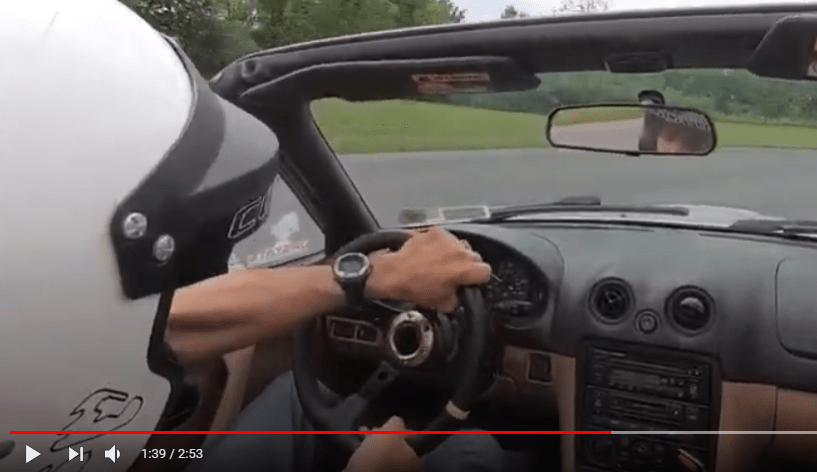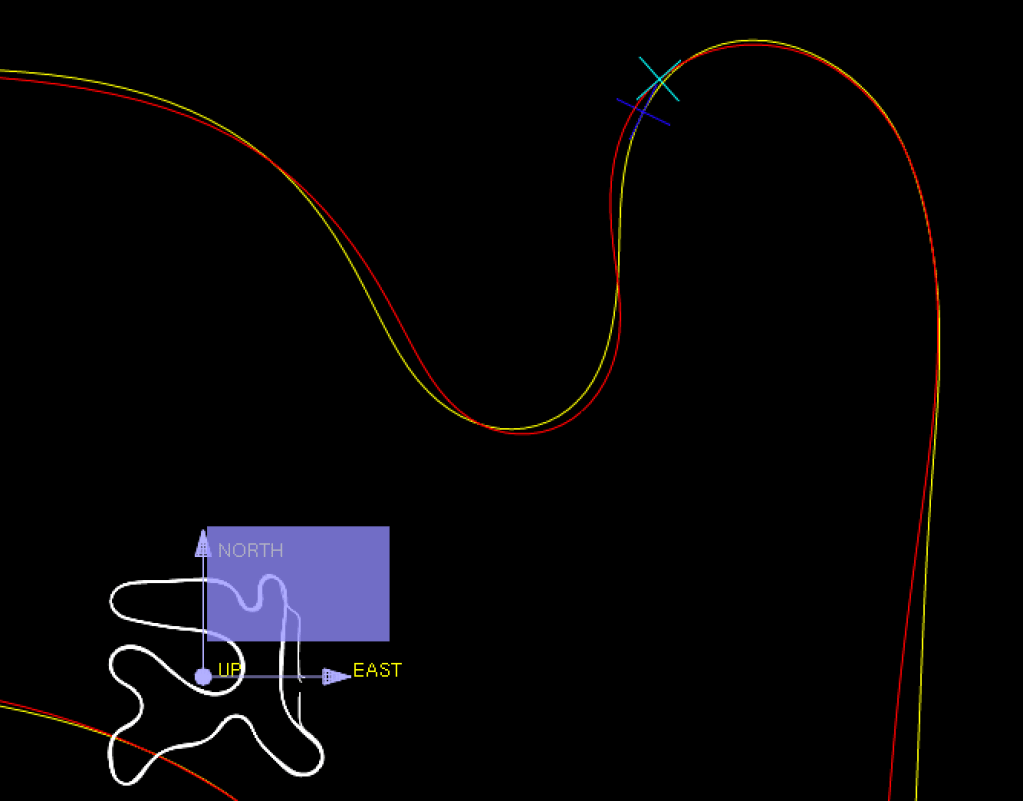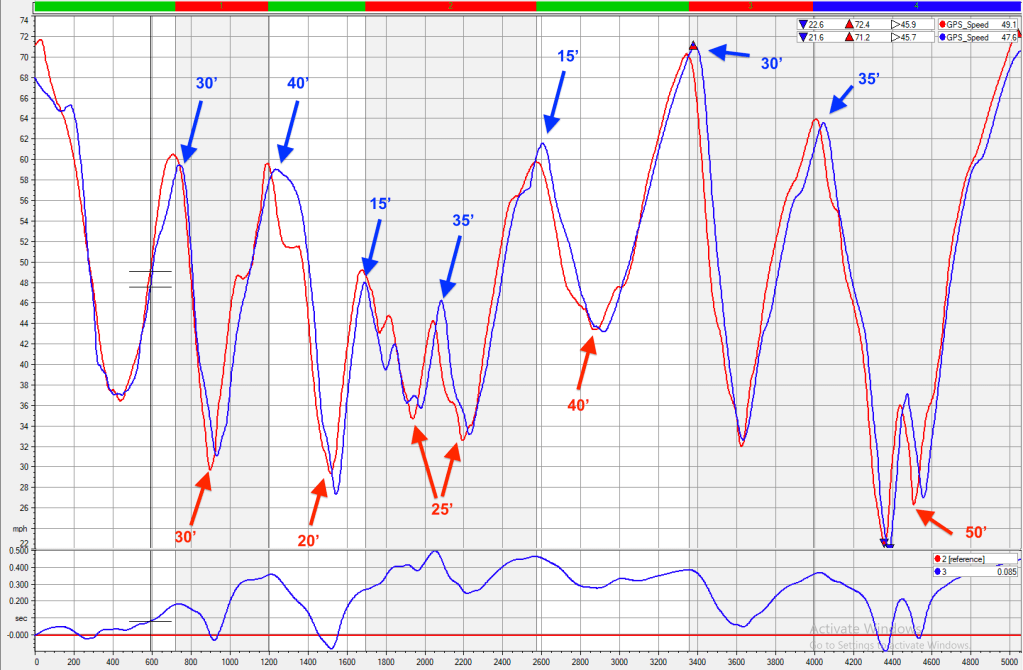During our “Lemons from Lemonade” track day, Ian and I got to drive a few different cars and compare driving styles. I have a lot of laps at Pineview Run, and it’s not exactly a fair contest when it comes to straight lap times. However, Ian has been to PV before (three years previously, he got four laps) and has logged a lot of sim time on it in Assetto Corsa. Ian is also instantly quick out of the box on every track we’ve been to, and typically buries me on lap times, so I don’t think he’s particularly handicapped.
NB1 Miata
Clayton’s 1999 is a dual duty car that’s more street than track. We usually fit whatever take-off tires we’re trying to get rid of, and on this day it was shod with cycled-out 225 RS4s on 15×8.5″ wheels. On fresher tires, the times would have been at least a second faster, but for comparative times, used up rubber would be fine.
First let’s look at Ian’s three fastest laps. You can see his lines are mostly on top of each other, and that he’s got the track dialed. But he’s still experimenting in T1, the Esses, and the Knuckle.

When I assemble his best sectors, he has a theoretical best lap of 1:19.927, which is about half a second faster than his best, 1:20.421. That’s damn consistent for such little track time.

I only did three laps in Clayton’s car, so I’m not going to show you my theoretical best, it’s my fast lap.
In general, Ian drives with more yaw, and he felt like the NB1 oversteered too much. Ian usually races a Yaris, which he has to aggressively trail brake to rotate, and a Miata will do that a lot easier, and that might have skewed his perceptions. I didn’t feel like the car oversteered at all, and my inputs and driving are more tidy. Here’s a lap of Ian first, then me.
Let’s take a look at how those laps compare on the speed/distance and time/distance graphs. For the first 1200′ of track, Turns 1-5, we are dead even. At 1300′, where the cursor is, Ian is faster and gains a bit of time. I’m not surprised, everyone is faster than me on this downhill section.

But I trail the brakes better into T7, and have a slightly higher min speed. If you look at the view from above (switching Ian to yellow here), you can see my approach is straighter, and I sacrifice some track width on the entry, but it works because I don’t have to move track left and can brake in a straighter line.

The most significant difference is how we go through the Uphill Esses. From 1700′ to 2300′ on the distance graph, I gain an easy half second. This is mostly using a tighter line. I wrote about this in my track guide, which Ian helped edit before it was published, so I’m surprised he’s not taking my advice here. See below.

Next is the Knuckle, and this corner is a perfect example of how differently we drive. If you look at the graph, this isn’t a big deal, because from 2400′ to 3400′, there’s only .1 seconds difference. So while the outcome is close, the strategy is different.
- Ian carries a higher entry speed and initially gains time on me. He brakes deep and stays in 2nd gear, using a line that optimizes acceleration out of the corner.
- I short shift into 3rd gear before the corner, and maintain a higher min speed.
From there, I trail brake better into the Blind Hairpin and keep a higher min speed, and this gains me another two or three tenths. And I gain about that much again going through the S-trap and T15, which we do very differently.

Ian’s Corner
This is the part of the blog post where Ian takes up the pen.
So which is the most important corner on the track? If you believe the usual wisdom, it’s the one that leads onto the longest straight. Alternatively, it’s the fastest corner. But if you look at the data, I’m actually losing a lot of time in the middle of the slowest corners. Any time spent going slow is bad, and in a slow corner, there’s a lot of time hanging around going slow.
If you watch the video, the most obvious difference is in the Knuckle, where I was experimenting with a lot of oversteer. I don’t normally drive that loose, I promise! In general, I like slinging the car all over and Mario likes driving tidy.
Beyond that one corner, the thing I noticed most was how differently we hold the steering wheel. You can see the muscles in his forearms quite clearly, his elbows are high, and he grips around the steering wheel with his thumb and fingers. In contrast, my forearms are more relaxed, my elbows are low, and I place my hands on top of the wheel, often with the thumb on top.


These differences in how we hold the wheel aren’t the causes of our driving styles but rather the result of them.
- I create oversteer on corner entry and maintain it mid-corner. The car rotates off the rear wheels, which makes the steering light.
- In contrast, Mario creates and maintains a little understeer as a way of feeling grip and maximizing minimum speed. The reason why his muscles are bulging is because the wheel is literally heavier as a result of understeer.
Despite being identical twins, we have completely different philosophies on how to navigate a corner. Which way is better? I think it depends on the car, track, and surface. I can say that over the course of the day I drove more and more like Mario. Understeer FTW.
NA6 Miata
Ian and I have driven my NA6 back to back a couple times. The first time was in 2018, when Pineview had just opened. At the time my car was at a lower spec (about 1/3 less power, an open diff, and Yok S.Drive tires), and we were going 9 seconds slower.
This was our first laps ever on this track, and so we were still figuring out which way the track goes. I see both of us making the same mistakes I wrote about in the Pineview track guide.
As it pertains to driving style, notice that Ian is howling the tires from the first corner, finding the limit, and making a lot of small steering inputs to correct. If you look at our runs through the Knuckle, not much has changed, for either of us. As Ian mentioned, I use understeer for traction sensing, and as a result I grab the wheel with Popeye forearms. Back then I was shuffle steering so much my hands looked like a groping teenager. These days I’m in a committed relationship with 9 and 3.
Fast forward three years and let’s take a look at some data from our Lemonade day. Again we are using up old rubber (Pineview is brutal on tires), so we’re on 14-year old NT01 tires that have lost much of their grip and wear imperceptibly.
These laps are from the end of the day, where Ian is experimenting and trying to adopt my driving style. First, let’s look at Ian’s best theoretical lap. He doesn’t leave much on the table, and his best possible lap is a 1:16.828, just two tenths faster than he went.

My theoretical best is a quarter second faster than my best, and I could muster a 1:16.424 if I could get my shit together.

Next is the speed trace of our fastest laps. He owns the first sector, I take it back from the Crick to the Esses, he beats me at my own game in the Knuckle, I eke out a bit in the Hairpin and the result is the identical twins have identical times exiting T14. But the final corner….

In Turn 15, I enter wider, get the car rotated early, and I’m on the gas sooner. These are things Ian is usually coaching me to do. But this time I do it better than he does, and when we cross Start/Finish, the result is .3 seconds.

Veloster
Ian and I have an ongoing discussion about why Pineview is especially cruel to FWD cars. I know this to be a fact, but he can’t wrap his head around it for the following reasons.
- On any other track, FWD is not at a disadvantage. As proof, he’ll cite the Miroshi videos at low-speed Tsukuba, and how the Inte-R beats on virtually everything.
- In the Pineview sim on Assetto Corsa, FWD doesn’t have a disadvantage. He’s tried all the cars, and I believe him.
- His Yaris out corners Miatas all the time, I’ve witnessed this firsthand.
And yet, at Pineview, in the real world, FWD cars are slower than their RWD or AWD counterparts. I have data from a Mini R50 on RE71R, a JCW on RS4, a Civic on Sur4G, and a Yaris on Conti ECS, and from Miatas on the same tires. In every case you can see it in the data, the FWD cars don’t have the same grip, but they get out of corners quickly. Ian will counter this data with “every car that over brakes on entry has good acceleration.” He’s also opined that perhaps Pineview hasn’t seen a good FWD driver yet. And I counter that with the list of seasoned FWD racers that have been to PV. And on and on the argument goes.
On this day, Ian and I would finally drive a good FWD car on good tires, back to back and settle this debate once and for all. For this A/B test we’d drive Chris Gailey’s Hyundai Veloster N on Falken RT660s. (As a data point, I drove Chris’s car last year on the stock PZ4s, which are about three seconds slower.)
I won’t do the whole blow-by-blow thing, because the biggest difference in our driving style is that Ian is consistently later on the brakes, and I’m consistently earlier on the gas. Take a look at the blue lines below – all of the peaks are to the right of the red lines. On average, Ian is braking two car lengths later than I am.
I think Ian was also trying very hard to get the Veloster to rotate, and it wouldn’t. He felt that a smidgen of traction or stability control was still on, and that the factory doesn’t allow you to remove all of it. Personally, I felt the car handled great, but I’m an understeer guy, and I’ve probably never properly rotated a FWD car.
But apparently I can drive OK that way, because if you look at the valleys, the red lines are all to the left of the blue lines. I’m backing up the corner better, and on average, I’m accelerating about two car lengths before he is. However, in the final corner, it’s a difference of three car lengths, and I get a little more time. This is pretty much the same thing we saw in my NA6.

In the end, I put down a really good lap and almost broke the all-time FWD lap record, I was just .2 seconds off! If Ian and I combined our best sectors, we’d have beaten the record by .2 seconds with a 1:15.136.
Does this mean that FWD cars aren’t handicapped at Pineview. No. Josh’s FRS had about the same lbs/hp ratio in 2019, and he was doing mid 1:14s on Z3s. On RT660s, he’d be doing 13s or less. Heck, Alyssa can do 1:14.5 in her 18 lbs/hp Miata on RS4s. Now I’m not as fast as those two aliens, but I should be able to do 14s on this tire and lbs/hp combination, and I can’t. I blame FWD.
So while we still don’t know why FWD is slower, there’s one thing we can conclude from this test, which is that I can drive a FWD car! Of the myriad reasons a FWD car is slower at Pineview, it’s not the driver. Or at least not this driver. Now we can concentrate on eliminating other factors, and maybe one day solve this mystery.
Ian’s final corner
Let’s start with the facts: Mario is faster at Pineview than me in every car we drove. He knows the course better, and his technique in slow corners is better. This isn’t very surprising. Over the last 2 years, he’s gone to Pineview dozens of times. In the last 2 years, I’ve had 6 hours of track time. It would be shocking if he wasn’t faster.
Rewind nearly 10 years ago, when we first started racing, and you would see that Mario was always faster than me by a few seconds per lap. Why? I think he understood traction better because of his motorcycling experience and a general knowledge of racing. I was of the opinion that cars were for commuting.
But then I started studying with books and simulators. I also got into data analysis and coaching. It took hundreds of hours, but eventually I became fast by educating my mind and body. After all that work, it was gratifying that I was a few seconds per lap faster.
And now Mario is faster than me at Pineview. Why? He started studying. He got into data and coaching. He changed his philosophy from “I just show up and drive, man” to “how am I going to train today?” There is no shortcut to the process. You have to put in the hours. You have to practice. You have to study. If you’re not being coached, you have to become introspective and actually critique yourself. It’s not always fun. It is rewarding though. Eventually.
I made sure to say “at Pineview” above because I think I still have the edge at many other tracks, especially unfamiliar ones. The reason is sim racing. I’m much more tuned into reference points than he is. I’m also more comfortable recovering from bad situations because I have the luxury of being able to do stupid shit in the virtual world I’d never do in the real world. Again, these differences are the result of a commitment to hundreds of hours of study and training. At the end of the day, or the race, or the blog post, let that be the final lesson.
